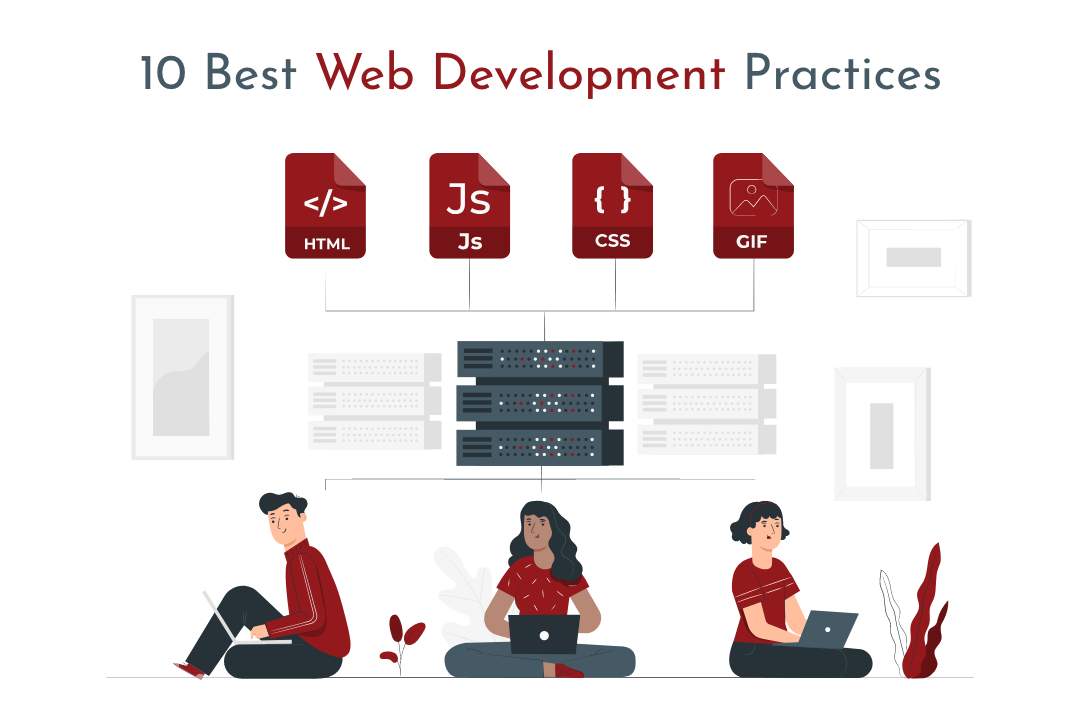
10 Web Development Best Practices to follow in 2020
By definition, web development is the work involved in developing a website for the World Wide Web. It could range from developing a single static page of plain text to complex web-based internet applications, electronic businesses, and social network services.
Businesses across the globe leverage this to develop different types of websites on the web to advertise and sell their products or services to potential customers.
The first step to successfully developing an application or a site on the web is to be completely clear about your business objectives.
This is the phase where, as a development team, you ask questions, to the stakeholders, about the possible intentions, purposes, and the business expectations of the project to have a crystal-clear scope of work in place. This leads to identifying and defining priorities and not focusing on insignificant activities that may derail your progress track.
It is important to have a well-defined process in place to sail smoothly on your way to the successful development and launch of the application in the market.
In the Software Development industry, they say, 80% of project success depends on 20% of actions, if performed correctly.
Let us take a look at the Top 10 best practices to follow during Website Development.
1. Create A Plan & Define Timelines
Break down the entire project into small, manageable chunks to begin the proceedings.
This aids in defining accurate timelines for the tasks.
Another important aspect, which is often overlooked, is the concept of designing and creating mock-ups and wire-frames.
It does not make sense to develop the application, solely based on the scope of the project, when you could design the mock-ups first, validate the designs for any corrections, and then proceed with coding.
Making changes to design is cost-effective than redeveloping the application.
Remember, the more time you spend on research and design, the lesser time you’ll have to spend on coding and programming!
2. Code Smartly
Writing codes should constitute a necessary purpose.
Each line of the program should solve a problem or implement a particular feature.
Practices like commenting on the code allow you to maintain transparency about the code snippet’s intended use.
This practice comes in handy when you’re working with multiple developers on a project.
You may also use code editors to expedite the task of writing codes.
Auto-suggestions, auto-completion features of a code editor can boost the coding process.
3. Use Frameworks
In web development, a framework provides you with a ready-made structure for development instead of starting everything from scratch.
It does not only save time but also assists in developing high-quality applications while significantly reducing the potential for errors.
If you’re planning to code in JavaScript then you may use jQuery, AJAX, or if it’s a PHP project then you may use frameworks like Laravel or CodeIgnitor.
4. Be Agile
Software Development Projects have a tight schedule to maintain. Do not allow a major feature to affect your timeline.
The purpose of going Agile is to rapidly deliver high-quality applications.
So, if a particular feature seems time-consuming and if it could affect the timelines of the existing sprint, try shipping it to the next sprint while replacing the feature with another important one, from the backlog, to cover the time difference.
This paves the way for creating an excellent quality product in less time.
And since software development required continuous improvement, adding incremental updates to a working project creates fewer bugs than planning to wait until the application is built completely.
5. Scope Of Work
Based out of the experience, expert developers, be it a front end developer or a backend developer, always suggest staying away from over-engineering your application to make it more robust than its intended use.
But it is also important to not let this thought close the doors for any potential innovation in the future.
There should always be room for accommodating innovation and improvement as and when required.
It is an inevitable fact that the current user interface of the application will become outdated over a while.
A smart way to counter this is to design and develop the backend of the application in a way that you can adjust the UI without having to do a full-fledged remodeling of the application.
This could be an extremely costly affair.
Also, anticipate making progressive updates, be it minor changes to the design of the application or introducing an entirely new feature to the application.
6. Multi-Device Compatibility
Studies have shown that a vast majority of users tend to visit websites from more than one device.
Devices such as smartphones, laptops, and tablets have different screen resolutions as well as form factors.
To ensure enriched user experience, it’s imperative to make sure the data is displayed accurately and responsively across all the available devices.
Besides, Google recommends having a custom design for your application to serve the convenience of your customers.
With a compatible and responsive application, you stand a better chance to rank higher on the Search Results Page.
7. Empowered CMS
A content management system (CMS) enables the admin to have control over the digitally published content and manage them quickly and efficiently.
The features and tools provided by the CMS are also useful for an admin to change the way an application and its content are showcased to the end-users, with an option to modify them on the go.
Regularly publishing new, original content not only captivates your audience, but it can also help you in achieving an invaluably long-term digital marketing momentum.
Including a back-end Content Management System in the application would allow your clients to post and edit the content as required.
8. Predefine The Page URLs
Create the page URLs because ultimately the end-users of the application are going to be human beings.
They must be readable and easy to understand.
Accessibility has always been a part of SEO, as search engines can leverage advanced user and user data signals to determine what people are engaging with.
So, page URL should be specific which represents the page content.
To conclude, the URL should be short for pages for users to find them on search engines easily.
9. Image Optimization
Optimizing images have loads of advantages to it like elevated user experience, faster page loading time, and additional search engine ranking opportunities.
Also, customize the image file names while uploading images to the media library of the application for alerting the search engine crawlers to the subject matter of the image and to improve the SEO.
10. Code To Test
Testing is an important step in the web development process.
Avoid writing codes that are hard or impossible to interpret and test.
It is always recommended to follow the industry standard practices of writing clean and easy-to-read-and-maintain code.
Depending on the project, define your course of writing optimal codes.
Some of the norms of writing codes include using a CSS reset, not mixing HTML with CSS, not using any JavaScript in your HTML docs, placing JavaScript files at the bottom of the docs, using conditional comments.
Another important point to be considered here is to test the code on various browsers simultaneously as you write them.
This is a proven method to save enormous hours that get spent while fixing cross-browser issues in the later stages of development.
Follow these web development practices to aid your cause of elevating the user experience of your client base and improving the online reach and the presence of your business.
Irrespective of the age of your application, it is important to follow the industry set standards of web development to help your organization achieve its business goals.
By definition, web development is the work involved in developing a website for the World Wide Web. It could range from developing a single static page of plain text to complex web-based internet applications, electronic businesses, and social network services.
Businesses across the globe leverage this to develop different types of websites on the web to advertise and sell their products or services to potential customers.
The first step to successfully developing an application or a site on the web is to be completely clear about your business objectives.
This is the phase where, as a development team, you ask questions, to the stakeholders, about the possible intentions, purposes, and the business expectations of the project to have a crystal-clear scope of work in place. This leads to identifying and defining priorities and not focusing on insignificant activities that may derail your progress track.
It is important to have a well-defined process in place to sail smoothly on your way to the successful development and launch of the application in the market.
In the Software Development industry, they say, 80% of project success depends on 20% of actions, if performed correctly.
Let us take a look at the Top 10 best practices to follow during Website Development.
1). Create a Plan and define timelines
Break down the entire project into small, manageable chunks to begin the proceedings.
This aids in defining accurate timelines for the tasks.
Another important aspect, which is often overlooked, is the concept of designing and creating mock-ups and wire-frames.
It does not make sense to develop the application, solely based on the scope of the project, when you could design the mock-ups first, validate the designs for any corrections, and then proceed with coding.
Making changes to design is cost-effective than redeveloping the application.
Remember, the more time you spend on research and design, the lesser time you’ll have to spend on coding and programming!
2). Code Smartly
Writing codes should constitute a necessary purpose.
Each line of the program should solve a problem or implement a particular feature.
Practices like commenting on the code allow you to maintain transparency about the code snippet’s intended use.
This practice comes in handy when you’re working with multiple developers on a project.
You may also use code editors to expedite the task of writing codes.
Auto-suggestions, auto-completion features of a code editor can boost the coding process.
3). Use Frameworks
In web development, a framework provides you with a ready-made structure for development instead of starting everything from scratch.
It does not only save time but also assists in developing high-quality applications while significantly reducing the potential for errors.
If you’re planning to code in JavaScript then you may use jQuery, AJAX, or if it’s a PHP project then you may use frameworks like Laravel or CodeIgnitor.
4). Be Agile
Software Development Projects have a tight schedule to maintain.
Do not allow a major feature to affect your timeline.
The purpose of going Agile is to rapidly deliver high-quality applications.
So, if a particular feature seems time-consuming and if it could affect the timelines of the existing sprint, try shipping it to the next sprint while replacing the feature with another important one, from the backlog, to cover the time difference.
This paves the way for creating an excellent quality product in less time.
And since software development required continuous improvement, adding incremental updates to a working project creates fewer bugs than planning to wait until the application is built completely.
5). Scope of work
Based out of the experience, expert developers, be it a front end developer or a backend developer, always suggest staying away from over-engineering your application to make it more robust than its intended use.
But it is also important to not let this thought close the doors for any potential innovation in the future.
There should always be room for accommodating innovation and improvement as and when required.
It is an inevitable fact that the current user interface of the application will become outdated over a while.
A smart way to counter this is to design and develop the backend of the application in a way that you can adjust the UI without having to do a full-fledged remodeling of the application.
This could be an extremely costly affair.
Also, anticipate making progressive updates, be it minor changes to the design of the application or introducing an entirely new feature to the application.
6). Multi-device compatibility
Studies have shown that a vast majority of users tend to visit websites from more than one device.
Devices such as smartphones, laptops, and tablets have different screen resolutions as well as form factors.
To ensure enriched user experience, it’s imperative to make sure the data is displayed accurately and responsively across all the available devices.
Besides, Google recommends having a custom design for your application to serve the convenience of your customers.
With a compatible and responsive application, you stand a better chance to rank higher on the Search Results Page.
7). Empowered CMS
A content management system (CMS) enables the admin to have control over the digitally published content and manage them quickly and efficiently.
The features and tools provided by the CMS are also useful for an admin to change the way an application and its content are showcased to the end-users, with an option to modify them on the go.
Regularly publishing new, original content not only captivates your audience, but it can also help you in achieving an invaluably long-term digital marketing momentum.
Including a back-end Content Management System in the application would allow your clients to post and edit the content as required.
8). Predefine the Page URLs
Create the page URLs because ultimately the end-users of the application are going to be human beings.
They must be readable and easy to understand.
Accessibility has always been a part of SEO, as search engines can leverage advanced user and user data signals to determine what people are engaging with.
So, page URL should be specific which represents the page content.
To conclude, the URL should be short for pages for users to find them on search engines easily.
9). Image Optimization
Optimizing images have loads of advantages to it like elevated user experience, faster page loading time, and additional search engine ranking opportunities.
Also, customize the image file names while uploading images to the media library of the application for alerting the search engine crawlers to the subject matter of the image and to improve the SEO.
10). Code to Test
Testing is an important step in the web development process.
Avoid writing codes that are hard or impossible to interpret and test.
It is always recommended to follow the industry standard practices of writing clean and easy-to-read-and-maintain code.
Depending on the project, define your course of writing optimal codes.
Some of the norms of writing codes include using a CSS reset, not mixing HTML with CSS, not using any JavaScript in your HTML docs, placing JavaScript files at the bottom of the docs, using conditional comments.
Another important point to be considered here is to test the code on various browsers simultaneously as you write them.
This is a proven method to save enormous hours that get spent while fixing cross-browser issues in the later stages of development.
Follow these web development practices to aid your cause of elevating the user experience of your client base and improving the online reach and the presence of your business.
Irrespective of the age of your application, it is important to follow the industry set standards of web development to help your organization achieve its business goals.



Freed Slaves and Roman Imperial Culture: Social Integration and the Transformation of Values ebook
Hey there, You’ve done a great job. I will certainly digg it and personally recommend to my friends. I’m sure they’ll be benefited from this site.